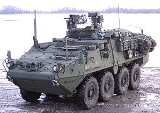
M1131 Fire Support Vehicle
Encyclopedia
The Fire Support Vehicle (FSV) of the Stryker
series provides automated enhanced surveillance
, target acquisition, target identification, target tracking, target designation, position location and communications functionality. Targets will be transmitted instantly to the fire support system and shooter.
due to the close parallels of operational requirements between the two vehicles. The FSV is an organic vehicle to the ICV maneuver formation and helps maximize commonality of the platform while simultaneously reducing the maintenance footprint and variety of logistics support.
Four combat radio nets (Co Cmd, Mortar Plt, FECC, Fires 1-4) allow secure voice and digital communications with, Initial Fire Support Automation System (IFSAS) or Advanced Field Artillery Tactical Data System (AFATDS), the maneuver command communications, and other fire support assets. FBCB2 is required for situation awareness and maneuver force communications in distributed operations and on the non-linear battlespace.
A vehicular intercom system (VIS) that enables communication on each of the four combat radio nets from each crew positions is required in the MAV-FSV. The VIS permits each of the operating stations to selectively monitor the intercommunications system and any combination of four radio receivers, while selectively transmitting on any of the radio transmitters in addition to the intercommunications system.
FS MAV must be capable of hosting the hand-held terminal unit and tactical radios for transmission of digital targeting and fire support data. Targeting data must be passed automatically to provide timely, error-free targeting information through digital means, to include spot reports providing updated situational awareness. Digital communications is required to all fire support assets to forward targeting data to the attack platforms without causing the platform operators to transcribe information and to allow for the automated processing of target, clearance, and firing data. The capability to communicate with all joint fire support assets allows the full utilization of the attack capabilities available.
as it is a work of the United States Military.
Stryker
The IAV Stryker is a family of eight-wheeled, 4-wheel-drive , armored fighting vehicles derived from the Canadian LAV III and produced by General Dynamics Land Systems, in use by the United States Army. The vehicle is named for two American servicemen who posthumously received the Medal of Honor:...
series provides automated enhanced surveillance
Surveillance
Surveillance is the monitoring of the behavior, activities, or other changing information, usually of people. It is sometimes done in a surreptitious manner...
, target acquisition, target identification, target tracking, target designation, position location and communications functionality. Targets will be transmitted instantly to the fire support system and shooter.
General
The FSV provides enhanced surveillance, target acquisition, target identification, target designation, and communications supporting the SBCT with ”first round“ fire-for-effect capability. It integrates the current M707 Striker Mission Equipment Package. The FSV provides the Fire Support Teams (FIST) with the capability to automate command and control functions, to perform fire support planning, directing, controlling and cross-functional area coordination, and execution.Operational Capability
The FSV is based on the ICVM1126 Infantry Carrier Vehicle
The M1126 Infantry Carrier Vehicle is an armoured personnel carrier and part of the Stryker family of vehicles , used by the United States Army.-General:...
due to the close parallels of operational requirements between the two vehicles. The FSV is an organic vehicle to the ICV maneuver formation and helps maximize commonality of the platform while simultaneously reducing the maintenance footprint and variety of logistics support.
Four combat radio nets (Co Cmd, Mortar Plt, FECC, Fires 1-4) allow secure voice and digital communications with, Initial Fire Support Automation System (IFSAS) or Advanced Field Artillery Tactical Data System (AFATDS), the maneuver command communications, and other fire support assets. FBCB2 is required for situation awareness and maneuver force communications in distributed operations and on the non-linear battlespace.
A vehicular intercom system (VIS) that enables communication on each of the four combat radio nets from each crew positions is required in the MAV-FSV. The VIS permits each of the operating stations to selectively monitor the intercommunications system and any combination of four radio receivers, while selectively transmitting on any of the radio transmitters in addition to the intercommunications system.
FS MAV must be capable of hosting the hand-held terminal unit and tactical radios for transmission of digital targeting and fire support data. Targeting data must be passed automatically to provide timely, error-free targeting information through digital means, to include spot reports providing updated situational awareness. Digital communications is required to all fire support assets to forward targeting data to the attack platforms without causing the platform operators to transcribe information and to allow for the automated processing of target, clearance, and firing data. The capability to communicate with all joint fire support assets allows the full utilization of the attack capabilities available.
Source
This article incorporates work from http://www.sbct.army.mil/product_fsv.html, which is in the public domainPublic domain
Works are in the public domain if the intellectual property rights have expired, if the intellectual property rights are forfeited, or if they are not covered by intellectual property rights at all...
as it is a work of the United States Military.

